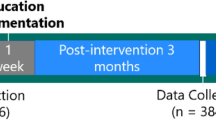Abstract
Typically, the international normalized ratio (INR) is monitored and warfarin dose adjusted, if necessary, to correct non-therapeutic INR after interacting medications, like prednisone, are initiated during warfarin therapy. Preemptively adjusting the warfarin dose is another approach. To evaluate the utility of preemptive warfarin dosage adjustment for preventing non-therapeutic INR following prednisone-warfarin co-administration. Patients were randomized to either a preemptive warfarin dose reduction between 10 and 20% (intervention) or reactive warfarin dose adjustment (control) within 72 h of warfarin-prednisone co-administration. Subjects received a follow-up INR within 7 days. Primary outcome was the occurrence of follow-up INR ≥ 1 point over the INR goal range upper limit. Secondary outcomes included INR control, purchases of prescription vitamin K, and warfarin-associated adverse events in the 30 days after prednisone initiation. Twenty and 17 patients comprised the intervention and control groups. The intervention group’s warfarin dose was reduced by a median of 11.8%. More control patients (n = 5) experienced an INR ≥ 1 point over the INR goal range upper limit compared to intervention (n = 2); however, the actual difference (29.4 vs.10.0%) was not statistically significant (P = 0.21). A higher percentage of intervention patients had a subtherapeutic follow-up INR compared to control (40 vs. 5.9%, P = 0.02). One patient from each group experienced warfarin-associated bleeding. No thromboembolic complications or vitamin K purchases were observed. For patients initiating prednisone therapy, preemptive warfarin dose reduction resulted in a non-significant reduction in supratherapeutic INR but increased the likelihood of subtherapeutic INR compared to INR monitoring with reactive warfarin dose adjustment.


Similar content being viewed by others
References
Hazlewood KA, Fugate SE, Harrison DL (2006) Effect of oral corticosteroids on chronic warfarin therapy. Ann Pharmacother 40:2101–2106. doi:10.1345/aph.1H418
Stading JA (2006) Effects of prednisone on the international normalized ratio. Am J Health-Syst Pharm 63:2354–2356. doi:10.2146/ajhp060105
Kaufman M (1997) Treatment of multiple sclerosis with high-dose corticosteroids may prolong the prothrombin time to dangerous levels in patients taking warfarin. Mult Scler 3:248–249. doi:10.1177/135245859700300406
Ansell J, Hirsh J, Hylek E, Jacobson A, Crowther M, Palareti G (2008) Pharmacology and management of the vitamin K antagonists. Chest 33:160S–198S. doi:10.1378/chest.08-0670
Hirsh J, Fuster V, Ansell J, Halperin JL (2003) American heart association/American College of cardiology foundation guide to warfarin therapy. J Am Coll Cardiol 41:1633–1652. doi:10.1016/S0735-1097(03)00416-9
Banet GA, Waterman AD, Milligan PE, Gatchel SK, Gage BF (2003) Warfarin dose reduction vs watchful waiting for mild elevations in the international normalized ratio. Chest 123:499–503. doi:10.1378/chest.123.2.499
Lexi-Comp Online, Lexi-Interact Online, Hudson, Lexi-Comp, Inc., Ohio 2009; Accessed 26 Oct 2009
Ahmed A, Stephens JC, Kaus CA, Fay WP (2008) Impact of preemptive warfarin dose reduction on anticoagulation after initiation of trimethoprim-sulfamethoxazole or levofloxacin. J Thromb Thrombolysis 26:44–48. doi:10.1007/s11239-007-0164-z
Witt DM, Sadler MA, Shanahan RL, Mazzoli G, Tillman DJ (2005) Effect of a centralized clinical pharmacy anticoagulation service on the outcomes of anticoagulation therapy. Chest 127:1515–1522. doi:10.1378/chest.127.5.1515
Crowther MA, Ageno W, Garcia D, Wang L, Witt DM, Clark NP, Blostein MD, Kahn SR, Vesely SK, Schulman S, Kovacs MJ, Rodger MA, Wells P, Anderson D, Ginsberg J, Selby R, Siragusa S, Silingardi M, Dowd MB, Kearon C (2009) Oral vitamin K versus placebo to correct excessive anticoagulation in patients receiving warfarin. Ann Intern Med 150:293–300
Clark NP, Witt DM, Delate T, Trapp M, Garcia D, Ageno W, Hylek EM, Crowther MA (2008) Thromboembolic consequences of subtherapeutic anticoagulation in patients stabilized on warfarin therapy: the low INR study. Pharmacotherapy 28:960–967. doi:10.1592/phco.28.8.960
Acknowledgments
We wish to acknowledge Drs. Ashley Howard, Pharm.D. and Morgan Youngblood, Pharm.D. for their assistance in enrolling study subjects.
Conflict of Interest
None.
Author information
Authors and Affiliations
Corresponding author
Rights and permissions
About this article
Cite this article
Dowd, M.B., Vavra, K.A., Witt, D.M. et al. Empiric warfarin dose adjustment with prednisone therapy. A randomized, controlled trial. J Thromb Thrombolysis 31, 472–477 (2011). https://doi.org/10.1007/s11239-010-0535-8
Published:
Issue Date:
DOI: https://doi.org/10.1007/s11239-010-0535-8




